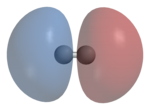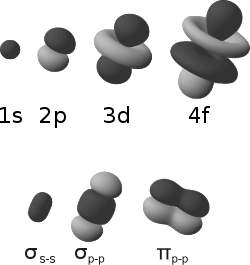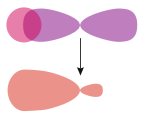248:
425:, one of the rings makes up the outer pentagon; the inside of that ring is the outside of the graph. This rule fails further when considering other shapes - toroidal fullerenes will obey the rule that the number of sigma bonds in a molecule is exactly the number of atoms plus the number of rings, as will nanotubes - which, when drawn flat as if looking through one from the end, will have a face in the middle, corresponding to the far end of the nanotube, which is not a ring, and a face corresponding to the outside.
111:
197:
233:
20:
266:
Sigma bonds are obtained by head-on overlapping of atomic orbitals. The concept of sigma bonding is extended to describe bonding interactions involving overlap of a single lobe of one
126:
diatomic molecules), bonding σ orbitals have no nodal planes at which the wavefunction is zero, either between the bonded atoms or passing through the bonded atoms. The corresponding
417:, which has 32 rings, 60 atoms, and 90 sigma bonds, one for each pair of bonded atoms; however, 60 + 32 - 1 = 91, not 90. This is because the sigma rule is a special case of the
421:, where each ring is considered a face, each sigma bond is an edge, and each atom is a vertex. Ordinarily, one extra face is assigned to the space not inside any ring, but
65:. In this formal approach, a σ-bond is symmetrical with respect to rotation about the bond axis. By this definition, common forms of sigma bonds are s+s, p
107:
molecular orbitals become blended. The extent of this mixing (or hybridization or blending) depends on the relative energies of the MOs of like symmetry.
409:
This rule fails in the case of molecules which, when drawn flat on paper, have a different number of rings than the molecule actually has - for example,
593:
406:, has three rings so that the rule gives the number of sigma bonds as 24 + 3 − 1 = 26. In this case there are 16 C−C sigma bonds and 10 C−H bonds.
394:
Molecules with rings have additional sigma bonds, such as benzene rings, which have 6 C−C sigma bonds within the ring for 6 carbon atoms. The
289:, have sigma bonds between the multiple bonded atoms. These sigma bonds can be supplemented with other bonding interactions, such as
460:
831:
586:
422:
520:
495:
624:
470:
274:
is described as consisting of ten sigma bonds, one each for the two C−C bonds and one each for the eight C−H bonds.
579:
336:, the number of sigma bonds in a molecule is equivalent to the number of atoms plus the number of rings minus one.
862:
85:(where z is defined as the axis of the bond or the internuclear axis). Quantum theory also indicates that
159:
is a sigma bond while a multiple bond is composed of one sigma bond together with pi or other bonds. A
887:
852:
836:
133:
Sigma bonds are the strongest type of covalent bonds due to the direct overlap of orbitals, and the
811:
536:
Kubas, Gregory (2002). "Metal
Dihydrogen and σ-Bond Complexes: Structure, Theory, and Reactivity".
282:
298:
771:
766:
240:
130:, or σ* orbital, is defined by the presence of one nodal plane between the two bonded atoms.
90:
737:
418:
410:
365:
313:
123:
8:
857:
751:
372:
247:
439:
286:
58:
826:
619:
516:
491:
466:
145:
86:
545:
24:
332:, and are often made up of many sigma bonds along with pi bonds. According to the
776:
391:, with 3 sigma bonds). There is no more than 1 sigma bond between any two atoms.
325:
110:
719:
703:
698:
614:
290:
267:
149:
62:
54:
881:
792:
732:
727:
708:
602:
434:
50:
96:
571:
693:
688:
683:
196:
168:
160:
156:
127:
566:
232:
675:
659:
395:
376:
95:. As a practical consequence of this mixing of diatomic molecules, the
549:
57:
along the internuclear axis. Sigma bonding is most simply defined for
797:
375:
with a number of bonds equal to the number of atoms minus one (as in
31:
664:
134:
47:
654:
384:
329:
271:
210:
164:
486:
Clayden, Jonathan; Greeves, Nick; Warren, Stuart (March 2012) .
459:
Moore, John; Stanitski, Conrad L.; Jurs, Peter C. (2009-01-21).
423:
141:
137:
in these bonds are sometimes referred to as sigma electrons.
19:
490:(2nd ed.). Oxford: OUP Oxford. pp. 101–136.
515:(1st ed.). Oxford: OUP Oxford. pp. 27–46.
485:
458:
53:. They are formed by head-on overlapping between
371:A molecule with no rings can be represented as a
879:
364:This rule is a special-case application of the
144:. When viewed down the bond axis, a σ MO has a
462:Principles of Chemistry: The Molecular Science
587:
510:
368:of the graph which represents the molecule.
277:
270:with a single lobe of another. For example,
173:
148:, hence resembling a similarly sounding "s"
601:
89:(MO) of identical symmetry actually mix or
594:
580:
511:Keeler, James; Wothers, Peter (May 2008).
23:σ bond between two atoms: localization of
285:that feature multiple bonds, such as the
109:
18:
312:), and even δ-bonds, as in the case of
261:
203:
114:1sσ* antibonding molecular orbital in H
880:
328:containing one or more rings, such as
575:
535:
319:
206:sigma bonds between atomic orbitals
13:
14:
899:
625:Introduction to quantum mechanics
560:
513:Chemical Structure and Reactivity
171:has one sigma plus two pi bonds.
140:The symbol σ is the Greek letter
246:
231:
195:
61:using the language and tools of
383:, with only one sigma bond, or
529:
504:
479:
452:
1:
445:
324:Organic molecules are often
7:
428:
10:
904:
283:Transition metal complexes
187:
46:are the strongest type of
845:
819:
810:
785:
759:
750:
717:
673:
642:
635:
610:
293:, as in the case of W(CO)
278:Multiple-bonded complexes
230:
194:
812:Molecular orbital theory
204:Symmetric (s–s and p–p)
163:has one sigma plus one
119:
27:
16:Covalent chemical bond
113:
22:
419:Euler characteristic
411:Buckminsterfullerene
366:Euler characteristic
314:chromium(II) acetate
262:Polyatomic molecules
752:Valence bond theory
122:For homodiatomics (
440:Molecular geometry
287:dihydrogen complex
120:
87:molecular orbitals
59:diatomic molecules
28:
875:
874:
871:
870:
846:Constituent units
827:Molecular orbital
806:
805:
786:Constituent units
746:
745:
620:Quantum mechanics
550:10.1021/ja0153417
544:(14): 3799–3800.
488:Organic Chemistry
320:Organic molecules
259:
258:
146:circular symmetry
895:
888:Chemical bonding
817:
816:
757:
756:
738:Exchange-coupled
640:
639:
603:Chemical bonding
596:
589:
582:
573:
572:
567:IUPAC-definition
554:
553:
538:J. Am. Chem. Soc
533:
527:
526:
508:
502:
501:
483:
477:
476:
456:
326:cyclic compounds
250:
235:
223:————————————————
199:
180:————————————————
174:
118:with nodal plane
25:electron density
903:
902:
898:
897:
896:
894:
893:
892:
878:
877:
876:
867:
841:
802:
781:
777:Lewis structure
742:
713:
669:
631:
606:
600:
563:
558:
557:
534:
530:
523:
509:
505:
498:
484:
480:
473:
457:
453:
448:
431:
416:
405:
401:
390:
382:
359:
352:
345:
334:sigma bond rule
322:
311:
307:
302:
296:
291:π-back donation
280:
264:
255:
251:
243:
236:
215:for comparison
214:
205:
188:
117:
106:
102:
84:
80:
76:
72:
68:
63:symmetry groups
55:atomic orbitals
17:
12:
11:
5:
901:
891:
890:
873:
872:
869:
868:
866:
865:
863:Antibonding MO
860:
858:Non-bonding MO
855:
849:
847:
843:
842:
840:
839:
834:
829:
823:
821:
814:
808:
807:
804:
803:
801:
800:
795:
789:
787:
783:
782:
780:
779:
774:
769:
767:Hybrid orbital
763:
761:
754:
748:
747:
744:
743:
741:
740:
735:
730:
724:
722:
715:
714:
712:
711:
706:
701:
696:
691:
686:
680:
678:
671:
670:
668:
667:
662:
657:
652:
646:
644:
637:
636:Types of bonds
633:
632:
630:
629:
628:
627:
617:
615:Atomic orbital
611:
608:
607:
599:
598:
591:
584:
576:
570:
569:
562:
561:External links
559:
556:
555:
528:
522:978-0199289301
521:
503:
497:978-0199270293
496:
478:
471:
450:
449:
447:
444:
443:
442:
437:
430:
427:
414:
403:
399:
388:
380:
362:
361:
357:
350:
343:
321:
318:
309:
305:
300:
294:
279:
276:
263:
260:
257:
256:
253:
244:
238:
228:
227:
224:
221:
217:
216:
207:
201:
200:
193:
185:
184:
181:
178:
150:atomic orbital
115:
104:
100:
82:
78:
74:
70:
66:
15:
9:
6:
4:
3:
2:
900:
889:
886:
885:
883:
864:
861:
859:
856:
854:
851:
850:
848:
844:
838:
835:
833:
830:
828:
825:
824:
822:
818:
815:
813:
809:
799:
796:
794:
793:Covalent bond
791:
790:
788:
784:
778:
775:
773:
770:
768:
765:
764:
762:
758:
755:
753:
749:
739:
736:
734:
731:
729:
726:
725:
723:
721:
716:
710:
707:
705:
704:5 (quintuple)
702:
700:
699:4 (quadruple)
697:
695:
692:
690:
687:
685:
682:
681:
679:
677:
672:
666:
663:
661:
658:
656:
653:
651:
648:
647:
645:
641:
638:
634:
626:
623:
622:
621:
618:
616:
613:
612:
609:
604:
597:
592:
590:
585:
583:
578:
577:
574:
568:
565:
564:
551:
547:
543:
539:
532:
524:
518:
514:
507:
499:
493:
489:
482:
474:
472:9780495390794
468:
464:
463:
455:
451:
441:
438:
436:
435:Bond strength
433:
432:
426:
424:
420:
412:
407:
397:
392:
386:
378:
374:
369:
367:
356:
349:
342:
339:
338:
337:
335:
331:
327:
317:
315:
303:
292:
288:
284:
275:
273:
269:
249:
245:
242:
234:
229:
225:
222:
219:
218:
212:
208:
202:
198:
192:
186:
182:
179:
176:
175:
172:
170:
166:
162:
158:
155:Typically, a
153:
151:
147:
143:
138:
136:
131:
129:
125:
112:
108:
98:
97:wavefunctions
94:
93:
88:
64:
60:
56:
52:
51:chemical bond
49:
45:
44:sigma overlap
41:
37:
33:
26:
21:
709:6 (sextuple)
676:multiplicity
649:
541:
537:
531:
512:
506:
487:
481:
461:
454:
408:
393:
370:
363:
354:
347:
340:
333:
323:
281:
265:
190:
154:
139:
132:
121:
91:
43:
39:
35:
29:
643:By symmetry
398:molecule, C
169:triple bond
161:double bond
157:single bond
128:antibonding
124:homonuclear
36:sigma bonds
853:Bonding MO
837:MO diagram
694:3 (triple)
689:2 (double)
684:1 (single)
446:References
396:anthracene
377:dihydrogen
798:Lone pair
772:Resonance
660:Delta (δ)
650:Sigma (σ)
191:orbitals
135:electrons
99:s+s and p
92:hybridize
32:chemistry
882:Category
820:Concepts
760:Concepts
429:See also
167:, and a
48:covalent
733:Singlet
728:Triplet
665:Phi (φ)
385:ammonia
330:benzene
272:propane
268:orbital
211:pi bond
189:Atomic
165:pi bond
40:σ bonds
655:Pi (π)
605:theory
519:
494:
469:
241:hybrid
226:—————
183:—————
358:rings
351:atoms
142:sigma
77:and d
73:, s+p
42:) or
832:LCAO
720:spin
517:ISBN
492:ISBN
467:ISBN
387:, NH
373:tree
718:By
674:By
546:doi
542:124
413:, C
379:, H
360:− 1
299:PCy
254:s–p
30:In
884::
540:.
465:.
415:60
404:10
400:14
353:+
346:=
316:.
308:(H
239:s–
220:——
209:A
177:——
152:.
103:+p
81:+d
69:+p
34:,
595:e
588:t
581:v
552:.
548::
525:.
500:.
475:.
402:H
389:3
381:2
355:N
348:N
344:σ
341:N
310:2
306:2
304:)
301:3
297:(
295:3
252:σ
237:σ
213:,
116:2
105:z
101:z
83:z
79:z
75:z
71:z
67:z
38:(
Text is available under the Creative Commons Attribution-ShareAlike License. Additional terms may apply.




